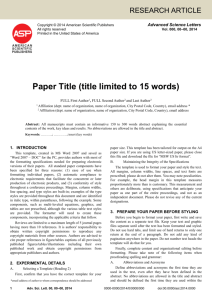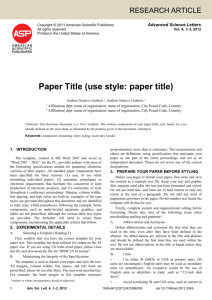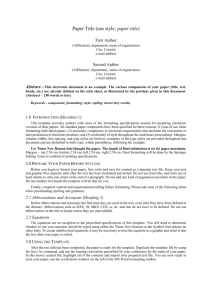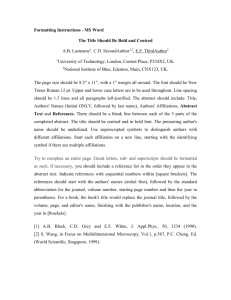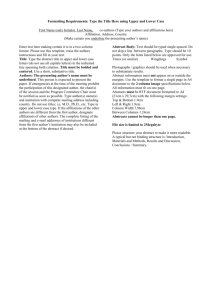ACOFT_Template 2015.doc
advertisement
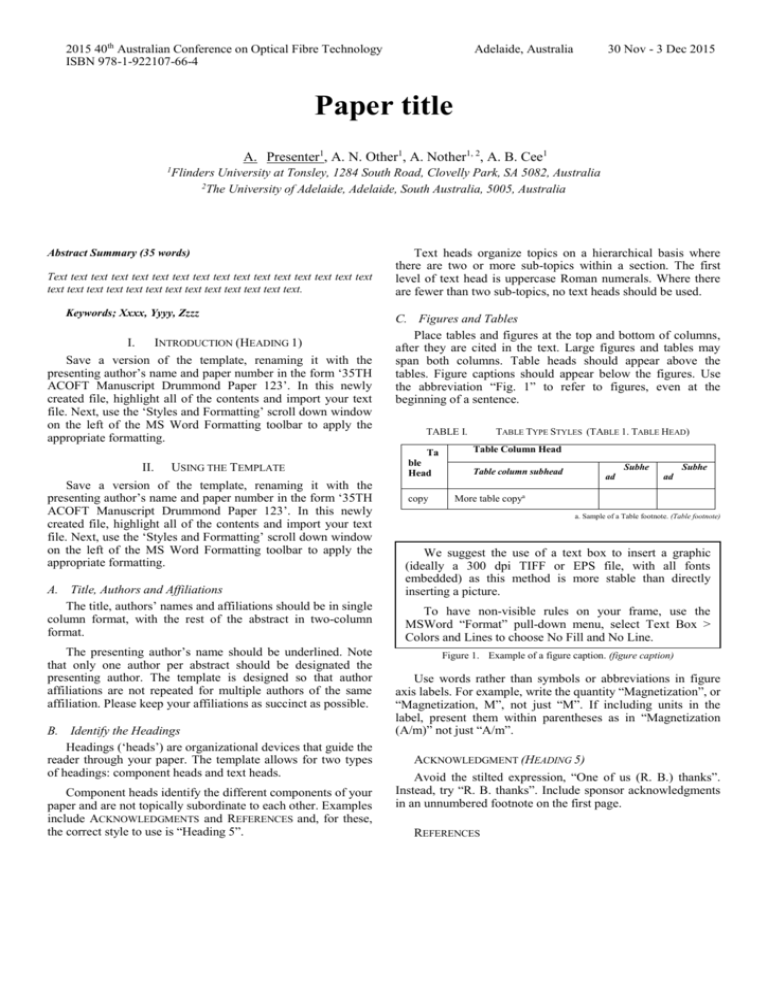
2015 40th Australian Conference on Optical Fibre Technology ISBN 978-1-922107-66-4 Adelaide, Australia 30 Nov - 3 Dec 2015 Paper title A. Presenter1, A. N. Other1, A. Nother1, 2, A. B. Cee1 1 Flinders University at Tonsley, 1284 South Road, Clovelly Park, SA 5082, Australia 2 The University of Adelaide, Adelaide, South Australia, 5005, Australia Abstract Summary (35 words) Text text text text text text text text text text text text text text text text text text text text text text text text text text text text text. Keywords; Xxxx, Yyyy, Zzzz I. INTRODUCTION (HEADING 1) Save a version of the template, renaming it with the presenting author’s name and paper number in the form ‘35TH ACOFT Manuscript Drummond Paper 123’. In this newly created file, highlight all of the contents and import your text file. Next, use the ‘Styles and Formatting’ scroll down window on the left of the MS Word Formatting toolbar to apply the appropriate formatting. II. USING THE TEMPLATE Save a version of the template, renaming it with the presenting author’s name and paper number in the form ‘35TH ACOFT Manuscript Drummond Paper 123’. In this newly created file, highlight all of the contents and import your text file. Next, use the ‘Styles and Formatting’ scroll down window on the left of the MS Word Formatting toolbar to apply the appropriate formatting. A. Title, Authors and Affiliations The title, authors’ names and affiliations should be in single column format, with the rest of the abstract in two-column format. The presenting author’s name should be underlined. Note that only one author per abstract should be designated the presenting author. The template is designed so that author affiliations are not repeated for multiple authors of the same affiliation. Please keep your affiliations as succinct as possible. B. Identify the Headings Headings (‘heads’) are organizational devices that guide the reader through your paper. The template allows for two types of headings: component heads and text heads. Component heads identify the different components of your paper and are not topically subordinate to each other. Examples include ACKNOWLEDGMENTS and REFERENCES and, for these, the correct style to use is “Heading 5”. Text heads organize topics on a hierarchical basis where there are two or more sub-topics within a section. The first level of text head is uppercase Roman numerals. Where there are fewer than two sub-topics, no text heads should be used. C. Figures and Tables Place tables and figures at the top and bottom of columns, after they are cited in the text. Large figures and tables may span both columns. Table heads should appear above the tables. Figure captions should appear below the figures. Use the abbreviation “Fig. 1” to refer to figures, even at the beginning of a sentence. TABLE I. Ta ble Head copy TABLE TYPE STYLES (TABLE 1. TABLE HEAD) Table Column Head Table column subhead Subhe ad Subhe ad More table copya a. Sample of a Table footnote. (Table footnote) We suggest the use of a text box to insert a graphic (ideally a 300 dpi TIFF or EPS file, with all fonts embedded) as this method is more stable than directly inserting a picture. To have non-visible rules on your frame, use the MSWord “Format” pull-down menu, select Text Box > Colors and Lines to choose No Fill and No Line. Figure 1. Example of a figure caption. (figure caption) Use words rather than symbols or abbreviations in figure axis labels. For example, write the quantity “Magnetization”, or “Magnetization, M”, not just “M”. If including units in the label, present them within parentheses as in “Magnetization (A/m)” not just “A/m”. ACKNOWLEDGMENT (HEADING 5) Avoid the stilted expression, “One of us (R. B.) thanks”. Instead, try “R. B. thanks”. Include sponsor acknowledgments in an unnumbered footnote on the first page. REFERENCES The template will number citations consecutively within brackets [1]. Sentence punctuation follows the bracket [2]. Refer simply to the reference number, as in [3]—do not use “Ref. [3]” or “reference [3]” except at the beginning of a sentence: “Reference [3] was the first . . .” Number footnotes separately with superscripts and place the actual footnote at the bottom of the column in which it is cited. Do not put footnotes in the reference list. Use letters for table footnotes. For a reference with six or more authors, “et al.” may be used. In other cases, list all authors’ names. Capitalize only the first word in a paper title, except for proper nouns and element symbols. Even if they have been submitted for publication, unpublished papers should be cited as “unpublished” [4]. Papers that have been accepted for publication should be cited as “in press” [5]. For papers published in translation journals, please give the English citation first, followed by the original foreign-language citation [6]. [1] [2] [3] [4] [5] [6] G. Eason, B. Noble, and I. N. Sneddon, “On certain integrals of Lipschitz-Hankel type involving products of Bessel functions,” Phil. Trans. Roy. Soc. London, vol. A247, pp. 529–551, April 1955. (references) J. Clerk Maxwell, A Treatise on Electricity and Magnetism, 3rd ed., vol. 2. Oxford: Clarendon, 1892, pp.68–73. I. S. Jacobs and C. P. Bean, “Fine particles, thin films and exchange anisotropy,” in Magnetism, vol. III, G. T. Rado and H. Suhl, Eds. New York: Academic, 1963, pp. 271–350. K. Elissa, “Title of paper if known,” unpublished. R. Nicole, “Title of paper with only first word capitalized,” J. Name Stand. Abbrev., in press. Y. Yorozu, M. Hirano, K. Oka, and Y. Tagawa, “Electron spectroscopy studies on magneto-optical media and plastic substrate interface,” IEEE Transl. J. Magn. Japan, vol. 2, pp. 740–741, August 1987 [Digests 9th Annual Conf. Magnetics Japan, p. 301, 1982].
